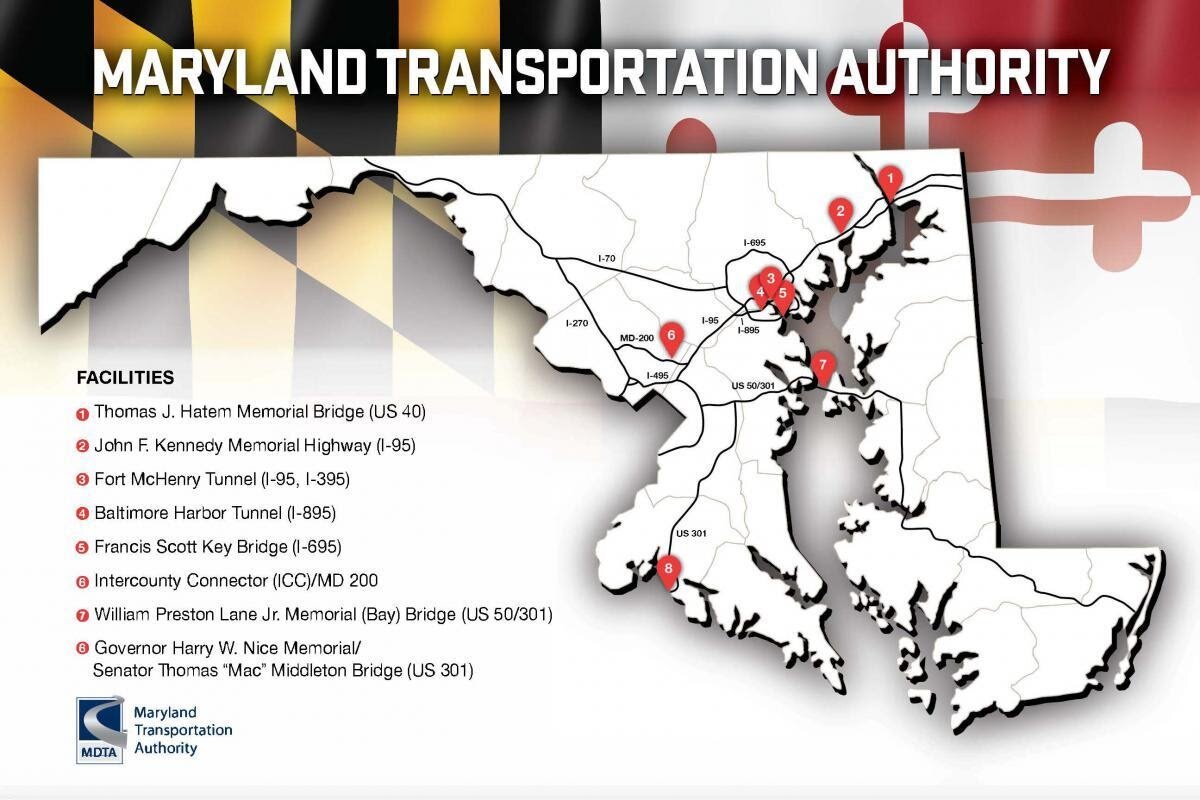Three years ago, Governor Larry Hogan announced his I-495 & I-270 Public-Private Partnership (P3) Program. The project would add toll lanes that private companies would design, build, operate, and collect tolls through a 50-year contract with the State. The Maryland Department of Transportation (MDOT) is rushing ahead with this complex, ever-changing process.
The entire P3 consists of more than 70 miles and encompasses all of I-270 and I-495 in Maryland, as well as the American Legion Bridge. The first phase of the project, known as Phase 1 includes the 37 miles section from the American Legion Bridge to I-270 and I-270 to I-70.
On Jan. 27, 2021, MDOT announced it had selected a preferred alternative from its list of build options. Ten days later, on February 18, 2021, MDOT and the Maryland Transportation Authority (MDTA) announced the selection of Accelerate Maryland Partners, LLC, to be the Phase Developer to oversee the predevelopment work of the Phase 1 P3 project. Refer to our February 21 newsletter for more information about the Accelerate Maryland Partners consortium and its team of companies.
The next steps in the approval process of the Developer Phase Agreement include: review and approval by the MDTA Board, review by the budget committees of the Maryland General Assembly, and approval by the Board of Public Works (BPW), although not necessarily in this order. The BPW has the final decision. If approved by the BPW, the Phase Developer contract would be awarded and Accelerate Maryland Partners notified to proceed with the preliminary design and collaboration with community stakeholders.
The final design for Phase 1 is slated for release by May 2022. The BPW must then approve a construction contract, which might occur in summer 2022, with construction possibly beginning around fall 2022. These dates may change because of both internal and external factors.
Action Item
Write Comptroller Franchot care of his point staff person, Tom Brennan, at tbrennan@marylandtaxes.gov. and/or call Comptroller Franchot at 301-332-1961. This is his cell phone and he said in a recent interview that he invites the public to contact him at this number and leave a voice mail or text.
Write Treasurer Kopp c/o her BPW liaison, Joanna Kille, at jkille@treasurer.state.md.us.
Write Governor Hogan at https://governor.maryland.gov/contact-the-governor/.
Tell them:
No P3 agreement should be approved by the BPW until the Final Environmental Impact Statement (FEIS) is completed. An FEIS is essential to adequately assess impacts to communities, utility conflicts, the environment, and parklands—and the 3,000 comments submitted during hearings on the project.
Governor Hogan’s statements that there will be no cost to Maryland taxpayers is false. In fact, Maryland taxpayers could be stuck with hundreds of millions of dollars in expenses and future costs. See our February 7 newsletter for more information on financial concerns.
Refer to the recent article in the Washington Post about high-profile problems with P3s across the country.
Please help us generate even more emails to Peter Franchot. His vote on the BPW is likely to decide whether this project continues to move forward—or not. If you belong to a homeowners association or civic association, please ask your group’s leaders to distribute this flyer to members. Thank you!
Important New Information from the Comptroller
On March 10, Comptroller Peter Franchot gave an interview (listen here, read more here) on the “Everyday Law” podcast in which he made some startling comments:
According to Comptroller Franchot, only the first phase of the 495-270 P3 is still on the table. He said, “There is no longer a Beltway widening project. There is no phase 2 or 3. It does not exist.
He claimed the P3 is now a $2 billion project, as opposed to the $12 billion project that would have included the Beltway.
He referred to the Phase 1 project as “experimenting with P3s.”
There has been no response from MDOT concerning these comments.
What is the Role of the Maryland Transportation Authority?
The MDTA is an independent State agency, which was founded in 1971 and is responsible for constructing and operating Maryland’s toll facilities. By State law, MDTA has the responsibility to fix, revise, and set toll rates. All of the MDTA’s projects and services are financed by toll revenue.
Currently, MDTA’s tolling system covers more than 775 road miles of major highways.
On Feb. 25, 2021, MDTA staff provided an update on range setting information for Phase 1 South prior to a Board meeting when the official MDTA staff proposal will be presented. The statutory public comment period will open and be advertised following Board approval to seek public input on the official staff proposal.
MDTA had planned to vote on the predevelopment contract on March 25. However, the vote was delayed because the Maryland Attorney General is reviewing a legal challenge filed by an unsuccessful bidder for the contract. Several steps by State officials remain before the protestor can begin court proceedings.
According to State law, the BPW could proceed with executing the contract if necessary to protect substantial State interests although it is unclear specifically what such State interests entail. The next MDTA Board meeting is scheduled for April 29.
What Impact Can the Maryland Legislature Have?
Under State law, the BPW may not approve a P3 Agreement until the budget committees of the General Assembly have had 30 days to review and comment. However, the legislative review is purely advisory and has no authority to stop the project.
MDOT must formally submit the Predevelopment Agreement (PDA) to the legislature before the 30-day review can begin. Members of the Senate Budget and Taxation Committee and the House Appropriations Committee will review the Phase 1 PDA. The House Transportation and Environment Subcommittee (Chair, Marc Korman) is expected to take a leading role in the review. Delegate Korman plans to arrange a public hearing, call witnesses, and allow public testimony.
It is unknown when MDOT will send the Agreement to the legislature — either concurrent with, or before the votes by the MDTA and BPW. The legislature is scheduled to adjourn on April 12, but does not have to be in session to complete the legislative review.
Legislative hearings could be an important opportunity to obtain relevant information before final contract decisions are made, bring transparency to the State’s plans, and identify potential risks, flaws and the project’s rationale, in a public forum covered by the press.
How Does the Board of Public Works Enable the Project to Proceed?
Maryland’s BPW was created in 1825 and subsequently modified in 1864. Its role is to ensure that State expenditures are necessary, fiscally responsible, fair, and lawful. There is no other state with a similar administrative body.
The Board reviews projects, contracts, and expenditure plans for state agencies. It is responsible for appropriating funds for most contracts exceeding $200,000. The BPW currently reviews about $440 million in proposed contracts every two weeks.
MDOT must obtain approval from the BPW for a contract with the Phase Developer to begin predevelopment design. For the project to move forward, two of the three BPW members must approve the agreement. The three members are: Comptroller Peter Franchot, Treasurer Nancy Kopp, and Governor Larry Hogan. Plans are for the BPW to vote on the Phase 1 South predevelopment proposal in April or May.
Update on the Bill to Protect Historic Cemeteries from Destruction by P3 Highway Projects
Senator Susan Lee and Delegate Sara Love have introduced companion bills SB960 and HB1373 (Highways-Public Private Partnerships-Cultural Preservation) to protect historic African American cemeteries, burial grounds, and cultural heritage sites from encroachment or destruction by proposed highway P3 projects that have not been approved by the State legislature.
A prime example of a threatened site is the Morningstar Moses Cemetery and Hall in Cabin John. The proposed widening of the Capital Beltway with four new toll-lanes could have dire consequences. This community has already been the victim of injustice in the early 1960’s when the original construction of the Beltway split the community in half. This bill would help prevent a further injustice, by requiring both houses of the General Assembly to approve a highway P3 project before the State could acquire right-of-way that encroaches on this site and others like it.
Additional background information was included in the March 20th newsletter about the cemetery and its potential destruction by the proposed highway widening as part of the I-495/I-270 toll-lane project.
SB960 has been referred to the Senate Education, Health and Environmental Affairs (EHE) Committee and the Senate Budget and Taxation Committee. We are hopeful that the bill will be scheduled for a hearing in the final week of session so we can increase the awareness of State policy-makers and the public to the imminent threat of destruction that this P3 poses to vulnerable communities in its path.
Action Item:
If you agree that this bill deserves consideration in the remaining days of the 2021 session, please write your legislators and urge them to request a hearing on SB960 in the Senate EHE Committee.
To view a video about the history of the cemetery and submit a form to tell your legislators to protect African American Cemeteries under threat by widening I-495 and I-270, go to:
Protect Historic African American Cemeteries Under Threat from Highway Expansion
Must Read Article
Maryland explores tightening law on public-private partnerships amid proposal to build new toll lanes, Washington Post, March 27, 2021
There’s Strength in Numbers. Please Help us Grow Our Mailing List
People who read our newsletters take action, and our elected officials take notice! Help spread the word about what we can do to safeguard our environment and promote healthy, efficient, and fair transportation options. Tell your friends and neighbors they can join our newsletter email list by going to https://dontwiden270.org/get-involved and checking the "keep me informed" box. Our website is https://dontwiden270.org/.
Want Links to Our Past Newsletters?
For links to the most recent dontwiden270.org newsletters, go to https://dontwiden270.org/ and scroll down to “What’s happening With 270?” For links to all of our newsletters dating back to August 2018, go to https://dontwiden270.org/news



